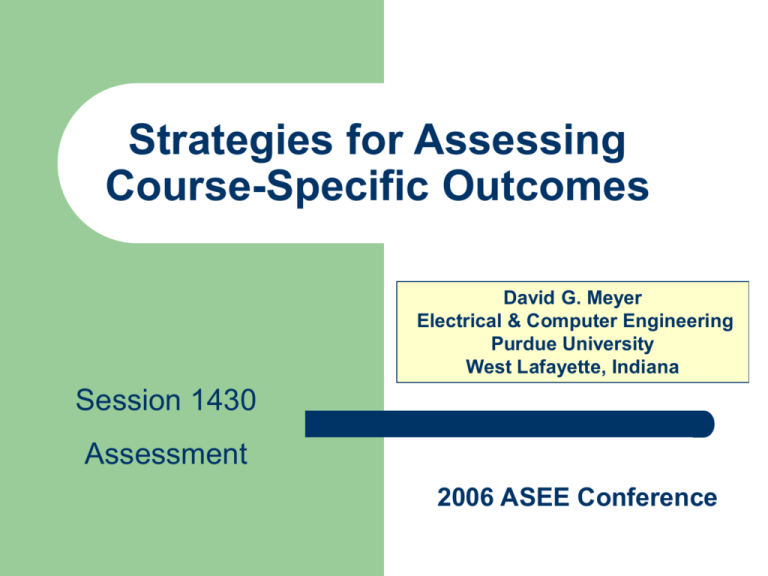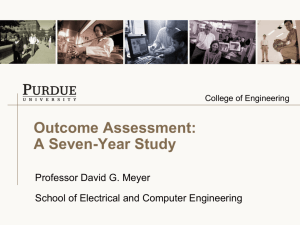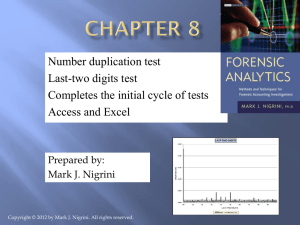Slides
advertisement

Strategies for Assessing
Course-Specific Outcomes
David G. Meyer
Electrical & Computer Engineering
Purdue University
West Lafayette, Indiana
Session 1430
Assessment
2006 ASEE Conference
Outline
Introduction
Outcome Assessment Trials (and Errors)
Incorporation of Dynamic Thresholds
Further Refinements
Results
Lessons Learned
Summary and Conclusions
Introduction
A proven method for satisfying the Accreditation
Board for Engineering and Technology (ABET)
“Criterion 3” requirements is the formulation of
outcomes specific to “core” courses in a
curriculum, which are tied to the program
outcomes.
This presentation summarizes a five-year study
on formulating and assessing course-specific
outcomes
Basic Questions Addressed
Formulation of content-specific learning
outcomes that can be consistently and
quantitatively assessed
Formulation of effective outcome assessment
instruments along with mechanisms to
determine outcome demonstration thresholds
Basic Questions Addressed
Formulation of grading strategies that
incorporate outcome demonstration thresholds
yet produce results consistent with prior
(accepted) grading practices (i.e., course GPA in
range of approximately 2.5 – 2.8 on a 4.0 scale)
Formulation of outcome remediation strategies
that are both fair and efficient
The Courses
ECE 270 – Intro to Digital System Design
(a sophomore lecture/lab course on digital logic
and system design)
ECE 362 – Microprocessor System Design and
Interfacing (a junior lecture/lab course on
embedded microcontrollers)
The Outcomes
Ten specific outcomes originally defined for ECE 270…
an ability to analyze static and dynamic behavior of digital circuits
an ability to map and minimize Boolean functions as well as represent
them in various standard forms
3. an ability to design and implement combinational logic circuits
4. an ability to use a hardware description language to specify a digital
circuit
5. an understanding of various combinational “building blocks” (e.g.,
decoders, multiplexers, encoders)
6. an ability to design and implement arithmetic logic circuits
7. an understanding of the behavior exhibited by latches and flip-flops
8. an ability to design and implement sequential circuits
9. an understanding of various sequential “building blocks” (e.g.,
counters, shift registers)
10. an ability to design and implement a simple computer
1.
2.
The Outcomes
…were ultimately compacted to the following six:
1.
2.
3.
4.
5.
6.
an ability to analyze static and dynamic behavior of digital
circuits
an ability to represent Boolean functions in standard forms, to
map and minimize them, and to implement them as
combinational logic circuits
an ability to use a hardware description language to specify
combinational logic circuits, including various “building blocks”
such as decoders, multiplexers, encoders, and tri-state buffers
an ability to design and implement arithmetic logic circuits
an ability to analyze, design, and implement sequential circuits
and use a hardware description language to specify them
an ability to design and implement a simple computer based
on combinational and sequential building blocks
The Outcomes
Four specific outcomes originally defined for ECE 362…
1. an ability to design and implement a simple
computer
2. an ability to write programs for a computer in
assembly language
3. an ability to interface a microprocessor to various
devices
4. an ability to effectively utilize the wide variety of
peripherals integrated into a contemporary
microcontroller
The Outcomes
…were refined as follows:
1. an ability to write programs for a computer in
assembly language
2. an ability to interface a microprocessor to various
devices
3. an ability to effectively utilize the wide variety of
peripherals integrated into a contemporary
microcontroller
4. an ability to design and implement a microcontrollerbased digital system
The Outcomes
…and will be compacted to the following three:
1. an ability to write programs for a computer in
assembly language
2. an ability to interface a microprocessor to various
devices
3. an ability to effectively utilize the wide variety of
peripherals integrated into a contemporary
microcontroller
Edict from the Visitors
“We want to see evidence of failing grades
assigned for cases in which students
[who would otherwise be passing but]
failed to successfully demonstrate one or
more course outcomes.”
Interpretation: We can’t just say that,
because a student earned a total score
above the “course passing threshold”, that
he/she has successfully demonstrated all
the course outcomes. Also, application of
outcome assessment should produce some
form of meaningful/measurable difference.
Major Issues
Balance
– fairness to students
providing students with a sufficient number of
opportunities to demonstrate course outcomes
ensuring that students’ own work is used as the
basis for outcome demonstration success
– overhead for instructor
keeping the incremental workload associated with
outcome assessment and tracking to a minimum
keeping the outcome assessment process
“contained” within a given term/semester
Major Issues
Evaluation Instruments
–
–
–
–
–
exams (whole or question subsets)
quizzes (written/oral)
homework assignments
labs
papers/projects/presentations
Passing Thresholds
–
–
–
static (what absolute value?)
dynamic (what algorithm?)
consistent with grading cutoff (A-B-C-D) thresholds
Major Issues
Assigning course grades consistent with
proven prior practice, yet reflecting meaningful
application of outcome assessment thresholds
Achieving consistency
–
–
–
–
–
semester-to-semester
professor-to-professor
course-to-course
school-to-school
institution-to-institution
Outcome Assessment Trials (and Errors)
Early (discarded) attempts
–
–
fixed passing threshold (60%) on weighted sum of
(selected) lab, homework, and exam scores
fixed passing threshold (60%) on primary assessment,
remediation homework, and final assessment
Main problems
–
–
basically everyone “passed” – strategy did not prove
to be effective
impossible to ensure that students’ own work was
being evaluated on labs and (remediation) homework
Outcome Assessment Trials (and Errors)
Restrict outcome assessment to exams only
–
–
fixed passing threshold (60%) on primary and final
assessments
use of “conditional failure” grade for those who would
otherwise be passing, with 3rd attempt for remediation
of failed outcome(s) the following semester
Main problems
–
–
–
fixed passing threshold became a significant factor:
hard (“impossible”) to write exams that produce a
predictable mean/distribution
lack of containment within term (“overhead leakage”)
grade inflation due to allowing final assessment to be
used as replacement score for all N outcomes
Incorporation of Dynamic Thresholds
Trial Five (Fall 2003 / Spring 2004)
–
–
–
–
dynamic thresholds on each primary and final
assessment (mean – standard deviation, with
bounded range of 40% to 60%)
must pass at least 50% of N (total) outcomes on the
primary assessments to qualify for a passing grade
final assessment can be used for remediation and/or
improvement (replacement) of score on up to N/2
outcomes
self-contained (no “overhead leakage” to following
semester)
Sample Exam Distribution (362, F’03)
DISTRIBUTION FOR PRIMARY ASSESSMENT OF ECE 362 COURSE OUTCOME 2
100%
90-99%
80-89%
70-79%
60-69%
50-59%
40-49%
30-39%
20-29%
10-19%
1-9%
NOT TAKEN
(
(
(
(
(
(
(
(
(
(
(
(
0)
6)
13)
31)
35)
35)
17)
9)
4)
2)
0)
2)
******
*************
*******************************
***********************************
***********************************
*****************
*********
****
**
**
Number of students = 152/154
Range of scores was from 13% to 99%
Average score = 61.3%
Standard deviation = 16.3
Outcome Demonstration Threshold = 45.0%
Further Refinements
Trial Six (Fall 2004 / Spring 2005)
–
–
–
–
same dynamic threshold strategy as Trial 5
final assessment used for remediation only
automatic exemption from final for students who
demonstrated all outcomes on the primary
assessments
must have a passing grade to qualify for the final
assessment (no restriction on number of outcomes
re-taken on final, but “passing grade” restriction was
intended to provide practical limit)
Further Refinements
Trial Seven (Fall 2005 / Spring 2006)
–
–
–
added limited opportunity for grade improvement on
final assessment
effective outcome score = weighted average of
primary and final assessments
number of outcomes re-taken limited to half
must have passing grade to qualify for final
workload associated with final greater than Trial 6, but
still somewhat less than prior trials
grade inflation associated with grade improvement on
final about an order of magnitude less than Trial 5
Trial 4 – Static thresholds, N replacement, 3 tries
Trial 5 – Dynamic thresholds, N/2 replacement
Trial 6 – Dynamic thresholds, no replacement
Results
Trial 7 – Dynamic thresholds, weighted average
Percent Successful
ECE270 Outcome Demonstration Success Rate
100
90
80
70
60
50
40
30
20
10
0
Primary
Final
4
5
6
Trial Number
7
Trial 4 – Static thresholds, N replacement, 3 tries
Trial 5 – Dynamic thresholds, N/2 replacement
Trial 6 – Dynamic thresholds, no replacement
Results
Trial 7 – Dynamic thresholds, weighted average
Percent Successful
ECE362 Outcome Demonstration Success Rate
100
90
80
70
60
50
40
30
20
10
0
Primary
Final
4
5
6
Trial Number
7
Trial 4 – Static thresholds, N replacement, 3 tries
Trial 5 – Dynamic thresholds, N/2 replacement
Trial 6 – Dynamic thresholds, no replacement
Results
Trial 7 – Dynamic thresholds, weighted average
Course Grade Point Average
4
GPA (4.0 Scale)
3.5
Desired range, based on
proven prior practice
3
2.5
ECE 270
ECE 362
2
1.5
1
0.5
0
4
5
6
Trial Number
7
Trial 5 – max{primary,final} = replacement on
up to N/2 outcomes
Trial 6 – no replacement (remediation only)
Results
Trial 7 – weighted average of primary and final on
up to N/2 outcomes
Final Assessment/Outcome Remediation Workload
Outcomes Per Student
1.6
1.4
1.2
1
ECE 270
ECE 362
0.8
0.6
0.4
0.2
0
5
6
Trial Number
7
Lessons Learned – A “Delicate Balance”
Assigning course grades consistent with proven
prior practice
Providing incentives for students to successfully
demonstrate outcomes, yet not causing grade
inflation and/or excessive instructor workload
Establishing reasonable, meaningful thresholds
for outcome demonstration success that are
decoupled from “exam difficulty”
Determining a fair level of pass/fail “filtering”
based on outcome demonstration success
Some Remaining Questions
What is an appropriate amount of outcomebased “filtering” for various kinds of courses?
–
–
currently averaging about 5-6% in ECE 362 and
about 15-20% in ECE 270
is this too much, too little, or about right?
What is an appropriate balance between
number of attempts allowed to demonstrate an
outcome, and the incremental workload
associated with managing this effort?
–
–
currently offer two attempts
is this too much, too little, or about right?
Summary and Conclusions
Different kinds of courses (e.g., “contentintensive” vs. “design-intensive”) require
different outcome assessment strategies
Finding an “optimal” strategy is non-trivial
What may appear to make the most sense
“on paper” (Trial 7) may not be the “best”
strategy when all factors are considered
(Trial 6)
Summary and Conclusions
Have the “basic questions” been answered?
–
–
–
–
Formulation of content-specific learning outcomes that can be
consistently and quantitatively assessed YES
Formulation of effective outcome assessment instruments
along with mechanisms to determine outcome demonstration
thresholds YES
Formulation of grading strategies that incorporate outcome
demonstration thresholds yet produce results consistent with
prior (accepted) grading practices (i.e., course GPA in range of
approximately 2.5 – 2.8 on a 4.0 scale) YES
Formulation of outcome remediation strategies that are both
fair and efficient YES (on balance)
More Information
Detailed information about the courses
discussed in this presentation can be found at
http://shay.ecn.purdue.edu/~dsml






